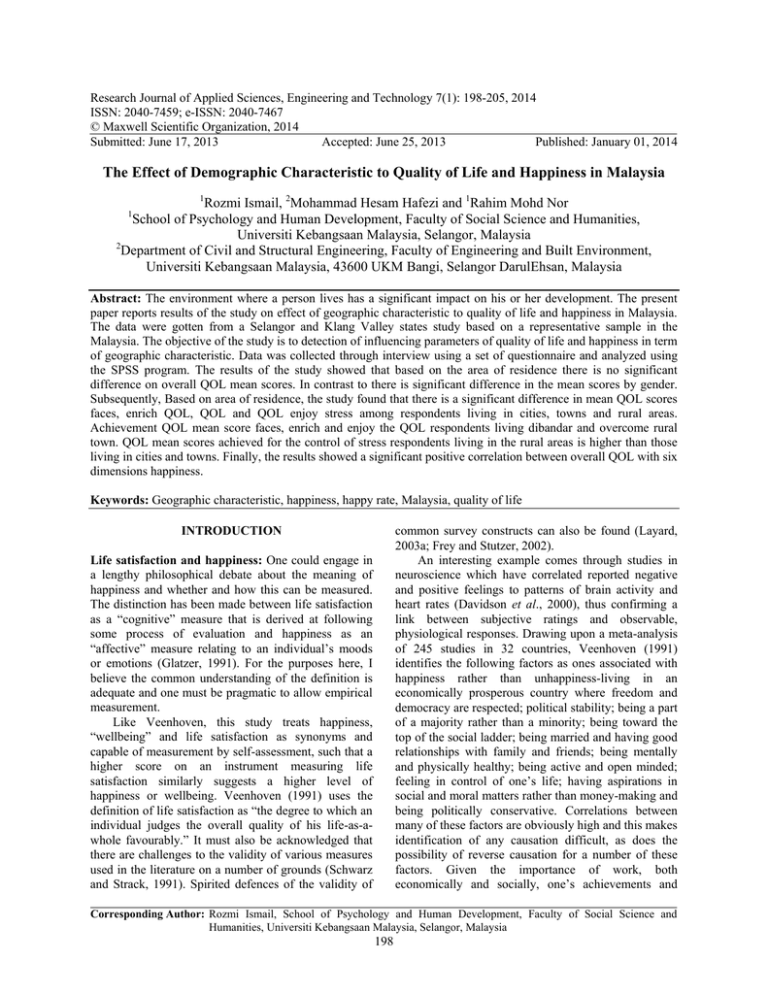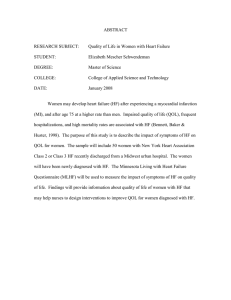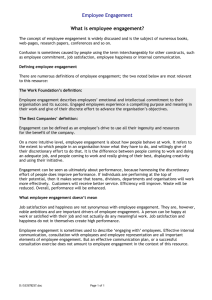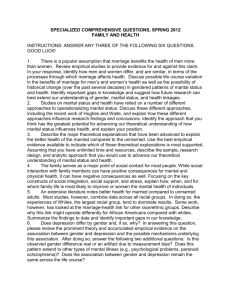Research Journal of Applied Sciences, Engineering and Technology 7(1): 198-205,... ISSN: 2040-7459; e-ISSN: 2040-7467
advertisement

Research Journal of Applied Sciences, Engineering and Technology 7(1): 198-205, 2014 ISSN: 2040-7459; e-ISSN: 2040-7467 © Maxwell Scientific Organization, 2014 Submitted: June 17, 2013 Accepted: June 25, 2013 Published: January 01, 2014 The Effect of Demographic Characteristic to Quality of Life and Happiness in Malaysia 1 Rozmi Ismail, 2Mohammad Hesam Hafezi and 1Rahim Mohd Nor School of Psychology and Human Development, Faculty of Social Science and Humanities, Universiti Kebangsaan Malaysia, Selangor, Malaysia 2 Department of Civil and Structural Engineering, Faculty of Engineering and Built Environment, Universiti Kebangsaan Malaysia, 43600 UKM Bangi, Selangor DarulEhsan, Malaysia 1 Abstract: The environment where a person lives has a significant impact on his or her development. The present paper reports results of the study on effect of geographic characteristic to quality of life and happiness in Malaysia. The data were gotten from a Selangor and Klang Valley states study based on a representative sample in the Malaysia. The objective of the study is to detection of influencing parameters of quality of life and happiness in term of geographic characteristic. Data was collected through interview using a set of questionnaire and analyzed using the SPSS program. The results of the study showed that based on the area of residence there is no significant difference on overall QOL mean scores. In contrast to there is significant difference in the mean scores by gender. Subsequently, Based on area of residence, the study found that there is a significant difference in mean QOL scores faces, enrich QOL, QOL and QOL enjoy stress among respondents living in cities, towns and rural areas. Achievement QOL mean score faces, enrich and enjoy the QOL respondents living dibandar and overcome rural town. QOL mean scores achieved for the control of stress respondents living in the rural areas is higher than those living in cities and towns. Finally, the results showed a significant positive correlation between overall QOL with six dimensions happiness. Keywords: Geographic characteristic, happiness, happy rate, Malaysia, quality of life common survey constructs can also be found (Layard, 2003a; Frey and Stutzer, 2002). An interesting example comes through studies in neuroscience which have correlated reported negative and positive feelings to patterns of brain activity and heart rates (Davidson et al., 2000), thus confirming a link between subjective ratings and observable, physiological responses. Drawing upon a meta-analysis of 245 studies in 32 countries, Veenhoven (1991) identifies the following factors as ones associated with happiness rather than unhappiness-living in an economically prosperous country where freedom and democracy are respected; political stability; being a part of a majority rather than a minority; being toward the top of the social ladder; being married and having good relationships with family and friends; being mentally and physically healthy; being active and open minded; feeling in control of one’s life; having aspirations in social and moral matters rather than money-making and being politically conservative. Correlations between many of these factors are obviously high and this makes identification of any causation difficult, as does the possibility of reverse causation for a number of these factors. Given the importance of work, both economically and socially, one’s achievements and INTRODUCTION Life satisfaction and happiness: One could engage in a lengthy philosophical debate about the meaning of happiness and whether and how this can be measured. The distinction has been made between life satisfaction as a “cognitive” measure that is derived at following some process of evaluation and happiness as an “affective” measure relating to an individual’s moods or emotions (Glatzer, 1991). For the purposes here, I believe the common understanding of the definition is adequate and one must be pragmatic to allow empirical measurement. Like Veenhoven, this study treats happiness, “wellbeing” and life satisfaction as synonyms and capable of measurement by self-assessment, such that a higher score on an instrument measuring life satisfaction similarly suggests a higher level of happiness or wellbeing. Veenhoven (1991) uses the definition of life satisfaction as “the degree to which an individual judges the overall quality of his life-as-awhole favourably.” It must also be acknowledged that there are challenges to the validity of various measures used in the literature on a number of grounds (Schwarz and Strack, 1991). Spirited defences of the validity of Corresponding Author: Rozmi Ismail, School of Psychology and Human Development, Faculty of Social Science and Humanities, Universiti Kebangsaan Malaysia, Selangor, Malaysia 198 Res. J. App. Sci. Eng. Technol., 7(1): 198-205, 2014 experiences at work and the quality of their working life is another very important component of overall satisfaction. Thus unemployment-deprivation of workcan similarly be expected to be important. The large literature addressing these relationships is discussed further below. A number of studies emphasise the importance of the quality of social relationships and the relative unimportance of income in determining satisfaction. Indeed, the literature is divided as to the presence of an income effect (Frijters et al., 2003). Kraft (2000) found that life satisfaction peaked at an income of around 45,000 DM and fell away either side and also estimates that a large increase in income (6,000 DM/month) is required to generate an equivalent (but opposite) impact of a marital separation (Frijters et al., 2003). Factors that contribute to positive affective feelings include social contact; sexual activity; success or achievement; physical activity; engagement in nature, reading or music; consumption of food or drink and alcohol. The relationship between life satisfaction and such affective states is not clear, but may well depend on the regularity with which they are experienced (Argyle and Martin, 1991). Several interesting debates arise from the consideration and attempted empirical measurement of wellbeing. What are the relative contributions of fixed personality traits, environmental circumstances and life events toward wellbeing? Is it actual circumstance or experiences that matter, or rather relativities to some perceived norm? It is clear that human beings have an intrinsic tendency to be happy and satisfied, or at least to report that they are happy and satisfied. When people are asked to rate their levels of happiness or life satisfaction on a scale the resulting distribution is highly skewed. If you picture a “neither satisfied nor dissatisfied” midpoint, the vast bulk of responses lie to the satisfied side of the scale. Clearly, a general sense of wellbeing is felt by people who have had experienced vastly different degrees of fortune and adversity. People seem to be far more satisfied with aspects of their “private domain”, such as their marriage, family life and job, than they are with things in the public domain, such as the social security system, public safety or the environment (Glatzer, 1991). The observation that, on scales of 0 (totally dissatisfied) to 100 (totally satisfied), a population mean in the range of 70 to 80 is a remarkably stable phenomenon across western countries and over time, led Cummins to propose a “Theory of Subjective Wellbeing Homeostasis” (Cummins et al., 2003). The theory proposes that humans have evolved such that subjective wellbeing is actively maintained at a positive level by psychological devices; much like the body biologically maintains blood temperature and blood pressure in a narrow range. Though there is a strong tendency toward this generalised sense of wellbeing, the homeostatic system can fail to maintain it given sufficiently adverse conditions, such as abject poverty or chronic pain. The psychological need for positive assessment relates only to the self-evaluation and at an abstract or generalised level. It is not violated by negative evaluations of specific dimensions comprising overall happiness or satisfaction (e.g., one’s health). Moreover, the homeostatic effect is weaker the less a factor relates to the evaluation of the self. Thus the theory explains why people are more negative about societal (“distal”) dimensions than those factors in their private (“proximal”) domain (Cummins et al., 2003). Is the observed variation in happiness or life satisfaction predominantly due to “fixed effects”, where certain individuals have a positive disposition and others a negative disposition towards life, or is satisfaction mainly shaped by life events? The truth appears to be some combination of the two. There are personality traits and relatively stable characteristics, such as being married, which are associated with higher levels of life satisfaction or positive affect. But life events also clearly have an impact. Headey and Wearing (1991) view these fixed effects as “stocks” and the life events as “psychic income”. Life events known to impact upon measured satisfaction and happiness include separations, the death of loved ones, job loss and changes in health status and effects are more variable in adolescence than in adulthood (Veenhoven, 1991). The impact of life events will also vary according to mediating factors such as personality traits. Social support networks for example, may improve wellbeing both directly and indirectly through an improved capacity to cope with life events. How transitory such effects are is another matter. Brickman et al. (1978) famous study of lottery winners and persons who became paralysed after accidents shows that human beings have a remarkable ability to cope with life events and that wellbeing is a relatively fixed trait rather than a result of accumulated life events. Such findings provide strong support for “adaptation level theory” which suggests that humans become accustomed to their circumstances or “level of stimuli” and that it is only when there is a change in the factors that contribute to satisfaction that there is a resulting change in overall satisfaction (Argyle and Martin, 1991). This theory is useful in explaining the absence of a robust relationship between income and satisfaction-it is only changes in income that invoke a change in satisfaction. This could be put more generally to say that it is deviations from the individual’s perceived norm that invokes heightened or diminished satisfaction. Thus it is not only the circumstances that the individual is accustomed to, but their circumstances relative to others around them that matter. A person’s income relative to the average income in their neighbourhood or socio-economic circle may be more 199 Res. J. App. Sci. Eng. Technol., 7(1): 198-205, 2014 important than absolute income in shaping feelings of satisfaction. Empirical support for the adaptation level theory and for the notion that comparisons are more important than absolutes can be readily found in the literature. The term “habituation” also appears for the phenomenon of people becoming satisfied with the circumstance they are used to and “rivalry” for the tendency of people to base their satisfaction on their circumstances relative to others (Layard, 2003b, c). By the same token, there are persons who are permanently happy or unhappy, in contradiction to the idea of adaptation. It is also clear that absolute conditions can have a very strong effect on wellbeing-at the international level there is a correlation between measured happiness and income per capita and the economic conditions in poverty stricken nations drastically reduces happiness (Veenhoven, 1991). that men were more satisfied with their marriages than women. Locksley (1980) found that wives experienced more upset by marital conflict, infrequent conversational or physical marital interactions and inadequacies in parenting than did husbands. Wives also reported more marital problems than husbands (Amato and Rogers, 1997) due to the fact that “husbands are less likely than wives to report on wives’ contributions to marital problems”. On the other hand, Zuo (1992) reports no gender differences between marital interaction and marital happiness. Beside that marital happiness also influenced by presence of children. Studies have concluded that marital happiness and quality are affected with the advent of children (Spanier and Lewis, 1980). Most parents see their children as positive influences (White et al., 1986); however, children may increase overall life satisfaction but lower marital satisfaction. Crohan (1996) found spouses who became parents were less positive in evaluating marital happiness after the birth of a child. There are various explanations for these phenomena. One possibility is that putting children first is sometimes a sign, result, or even a cause of a failed marriage, whereas putting the marriage relationship first is a key to successful child rearing (Altrocchi, 1988). Lawson (1988) found that couples had the lowest marital satisfaction during childbearing years, which may be due to spouses spending more time and energy on caring for their children than on themselves. The majority of studies show that marital happiness diminishes with children. Some of this research shows the effects are different for men and women (Lupri and Frideres, 1981). Using a female sample, Rogers (1999) found role strain among mothers. As the number of children increased, “full-time employment is associated with less marital happiness”. Helms-Erickson (2001) examines the association between marital quality and personal well-being using meta-analytic techniques. Effects from 93 studies were analyzed. The average weighted effect size r was 0.37 for cross-sectional and 0.25 for longitudinal effects. Results indicate that several variables moderate the association between marital quality and personal wellbeing, including gender, participants’ marital duration, source of measurement, data collection year and dependent variable. Mary and Nienstedt (1985) investigate the causes of happiness and unhappiness among housewives, husbands of housewives, working wives and husbands of working wives. Stage of the life cycle plays an important role in determining happiness for men but not for women. Similarities in the causes of happiness also are found: for all four groups, marital happiness is the most important determinant of overall happiness and (from a separate analysis) job satisfaction is the most important determinant of unhappiness. Marital happiness: Marital happiness has been found to be the most important factor in determining global happiness (Glenn and Weaver, 1981; Holland-Benin and Cable-Nenstedt, 1985). Reports of marital happiness, however, are subjective and often biased for socially acceptable answers (Anderson et al., 1983), a problem we have tried to overcome by using a reliable scale to measure happiness (Booth et al., 1995). Higher satisfaction in relationships has been found when partners perceive that the proportion of outcomes to investments is equal between partners, a situation of equity (Walster et al., 1978). In contrast, other research found that relationships are most satisfying and stable when partners perceive equality, regardless of investments (Lloyd and Cate, 1985). Kother (1985) found high marital quality in couples who shared division of labor and responsibilities. Schafer and Keith (1981) found that equity increased and inequity decreased over the family life cycle for both husbands and wives, whereas Wilkie et al. (1998) found that the definitions of equity differed between the genders. Earlier marriage research generally showed that marital happiness declined initially after marriage and increased in later stages of the life cycle (Anderson et al., 1983; Rollins and Cannon, 1974). Later, Glenn (1998) stated that those results may be a cohort effect and he argues that data from successive groups of American General Social Survey respondents do in fact support the notion of a general decline in marital success with recent cohorts. Giblin (1994) also found that the cohort effect explains differences in marital happiness over time. It is also possible that personality factors may influence these results. Meyers and Booth (1999) reported the personal resource of marital locus of control affected marital happiness, while Schafer et al. (1996) found the dynamics of within dyad interaction affected marital happiness. There are gender differences in marital happiness. Rhyne (1981) found 200 Res. J. App. Sci. Eng. Technol., 7(1): 198-205, 2014 The association between marital quality and personal well-being is demonstrated in the literature on marital relationships (Whisman and Bruce, 1999). Individuals experiencing marital dissatisfaction tend to report higher levels of depressive symptomatology than those who are satisfied (Beach et al., 1986; Culp and Beach, 1998). Marital satisfaction is associated positively with wives’ life satisfaction (Freudiger, 1983) as well as with wives’ and husbands’ reports of global happiness (Glenn and Weaver, 1981) and selfesteem (Voss et al., 1999). Marital predictors of wellbeing have been variously labeled marital quality, success, happiness, satisfaction, discord, adjustment and well-being (Fincham and Bradbury, 1987; Lewis and Spanier, 1982). Empirical support exists linking these variables to spouses’ personal well-being. For example, both cross-sectional and longitudinal studies have found an association between spouses’ personal well-being and marital love and conflict (Cox et al., 1999), marital satisfaction (Beach et al., 1986) and marital discord (Christian et al., 1994). RESULTS AND DISCUSSION Table 1 shows the demographic profile of respondents. Survey respondents reside in cities and towns reached 61.5% and the remaining 38.5% of the rural areas. Respondents are those who are married are composed of 42.9% males and 57.1% females. Umumur average respondent is 40 years, with the majority of respondents age 30-50 year old respondents. On the economic front, the average household income is nearly 47.0% 3.760 RM 1.000 to 3.000 RM-income and 53.0% of the respondents have income from 3.000 to 5.000 Rs. Based on Table 2 show that the value of alpha constructs cronbanch 0759 to 8759 study. The alpha value is good enough to meet to be a reliable instrument in measuring the study variables. Based on area of residence, also in no significant difference on overall QOL mean scores. But in contrast to the mean scores by gender (Table 2). Based on area of residence (Table 2), the study found that there is a significant difference in mean QOL scores faces, enrich QOL and QOL enjoy stress among respondents living in cities, towns and rural areas. Achievement QOL mean score faces, enrich and enjoy the QOL respondents living dibandar and overcome rural town. QOL mean scores achieved for the control of stress respondents living in the rural areas is higher than those living in cities and towns. RESEARCH METHODOLOGY Population and sample: This study is conducted by using quantitative approach. A total number of respondents this study is 1,005 people in Malaysia peninsular. A clustered random sampling base on four zone of 13 of states in Malaysia peninsular was used in this study. A total 1,005 respondents comprising of 431 males and 574 females were selected as a sample for the study. Respondent were also representative of the various races in Malaysia, namely the Malay, Chinese and Indian. Based on census 2010 shows that Malaysia total population is 28.3 million. Table 1: Demographic profile of the respondents (N = 1005) Characteristics N Gender Male 431 Female 574 Age Below 30 215 30-40 313 40-50 277 50-60 162 Above 60 38 Monthly income RM 1,000 and below 163 RM 1,001-2,000 173 RM 2,001-3,000 135 RM 3,000-4,000 141 RM 4,000-5,000 111 Above RM 5,000 282 Areas of residence City (urban) 347 Town (urban) 271 Village (rural) 387 Instrument: This study used instrument to measure responden’s QOL overall (14 items). Responden’s circled their satisfaction agreement to the items using the 7-point likert (1 = not satisfied at all, 2 = not satisfied, 3 = not really satisfied, 4 = mix feelings, 5 = quite satisfied, 6 = satisfied and 7 = very satisfied). Instrument also used to measure six dimension of respondent’s happiness namely: • • • • • • Faces (20 items) Enrich (15 items) Physical (10 items) Emotion (10 items) Stress (10 items) Life enjoy (11 items) Table 2: Reliability analysis by happiness’s construct Dimension 1. Qol faces 2. Qol enrich 3. Qol physical 4. Qol emotion 5. Qol stress 6. Qol life enjoy 7. Qol overall Respondent’s circled their agreement to the items using the 5-point likert (1 = strongly disagree, 2 = disagree, 3 = not sure, 4 = agree and 5 = strongly agree). Data is analyzed using t-test and multiple regression. 201 (%) 42.9 57.1 21.4 31.1 27.6 16.1 3.8 16.2 17.2 13.4 14.0 11.0 28.1 34.5 27.0 38.5 Cronbach’s α 0.802 0.759 0.886 0.811 0.880 0.895 0.875 Res. J. App. Sci. Eng. Technol., 7(1): 198-205, 2014 Table 3: Mean of the quality of life dimensions by areas of residence (N = 1005) Dimension Whole respondent City only Qol faces 3.46 (0.42) 3.46 (0.40) Qol enrich 3.92 (0.58) 4.01 (0.55) Qol physical 3.80 (0.51) 3.78 (0.57) Qol emosi 3.71 (0.63) 3.71 (0.66) Qol stress 3.58 (0.72) 3.48 (0.73) Qol life enjoy 3.55 (0.56) 3.59 (0.51) Qol overall 5.35 (0.84) 5.39 (0.80) Mean (S.D.); **: Significant at level 1%; *: Significant at level 5% Table 4: Association between overall quality of life and happiness dimension Dimension 1 2 3 1. Qol faces 1 2. Qol enrich 0.45** 1 3. Qol physical 0.05 0.24** 1 4. Qol emosi 0.12** 0.29** 0.65** 5. Qol stress 0.07* 0.22** 0.38** 6. Qol life enjoy 0.44** 0.45** 0.12** 7. Qol overall 0.34** 0.56** 0.29** Town only 3.51 (0.43) 3.99 (0.59) 3.82 (0.47) 3.69 (0.56) 3.52 (0.69) 3.65 (0.54) 5.41 (0.82) Village only 3.42 (0.45) 3.82 (0.61) 3.81 (0.50) 3.72 (0.65) 3.71 (0.71) 3.45 (0.60) 5.27 (0.89) 4 5 6 7 1 0.48** 0.13** 0.33** 1 0.05 0.27** 1 0.46** 1 Table 5: Trend of regression analysis by areas of residence Dimension Whole respondent City only Town only R2 value 0.410 0.428 0.457 Un-standardized B Qol faces (x1) 0.079 0.166 -0.041 Qol enrich (x2) 0.512** 0.459** 0.497** Qol physical (x3) 0.116* 0.024 0.278** Qol emosi (x4) 0.106* 0.092 0.114 Qol stress (x5) 0.133** 0.094* 0.100 Qol life enjoy (x6) 0.386** 0.443** 0.424** Overall quality of life as dependent variable; **: Significant at level 1%; *: Significant at level 5% 202 F value 3.255* 10.816** 0.522 0.202 10.713** 12.159** 2.864 Village only 0.446 0.027 0.562** 0.230** 0.055 0.187** 0.354** Res. J. App. Sci. Eng. Technol., 7(1): 198-205, 2014 Fig. 1: Relationship between quality of life with happiness dimension (N = 1005) REFERENCES Based on the findings of the study (Table 3) it can be concluded that there is no significant difference in overall QOL scores based on gender and area of residence. Yet there are significant differences QOL mean scores residential areas to control stress. Furthermore Table 4 and Fig. 1. Clarify the relationship between the study constructs. The results showed a significant positive correlation between overall QOL with six dimensions happiness. Altrocchi, J., 1988. Happy traditional and companionship marriages. J. Contemp. Soc. Work, 69: 434-442. Amato, P.R. and S.J. Rogers, 1997. A longitudinal study of marital problems and subsequent divorce. J. Marriage Fam., 59: 612-624. Anderson, S.A., C.S. Russell and W.R. Schumm, 1983. Perceived marital quality and family life-cycle categories: A further analysis. J. Marriage Fam., 45: 127-139. Argyle, M. and M. Martin, 1991. The Psychological Causes of Happiness. In: Strack, F., M. Argyle and N. Schwarz (Eds.), Subjective Well-being: An Interdisciplinary Approach. Pergamon Press, Great Britain, pp: 77-100. Beach, S.R.H., I. Arias and K.D. O’Leary, 1986. The relationship of marital satisfaction and social support to depressive symptomatology. J. Psychopathol. Behav., 8: 305-317. Booth, A., D.R. Johnson, L. White and J.N. Edwards, 1995. Marital Instability Over the Life Course [United States]: A Three Wave Panel Study, 19801988 (2nd ICPSR Eds.) [Computer file]. InterUniversity Consortium for Political and Social Research [producer and distributor], Ann Arbor, MI. Brickman, P., D. Coates and R. Janoff-Bulman, 1978. Lottery winners and accident victims: Is happiness relative? J. Pers. Soc. Psychol., 36: 917-927. Christian, J.L., D.K. O’Leary and D. Vivian, 1994. Depressive symptomatology in mutually discordant women and men: The role of individual and relationship variables. J. Fam. Psychol., 8: 32-42. Cox, M.J., B. Paley, M. Burchinal and C.C. Payne, 1999. Marital perceptions and interactions across the transition to parenthood. J. Marriage Fam., 61: 611-625. Crohan, S.E., 1996. Marital quality and conflict across the transition to parenthood in African American and white couples. J. Marriage Fam., 58: 933-944. CONCLUSION The results of the study showed that based on the area of residence there is no significant difference on overall QOL mean scores. In contrast to there is significant difference in the mean scores by gender. Subsequently, Based on area of residence, the study found that there is a significant difference in mean QOL scores faces, enrich QOL, QOL and QOL enjoy stress among respondents living in cities, towns and rural areas. Achievement QOL mean score faces, enrich and enjoy the QOL respondents living dibandar and overcome rural town. QOL mean scores achieved for the control of stress respondents living in the rural areas is higher than those living in cities and towns. Based on the findings of the study (Table 5) it can be concluded that there is no significant difference in overall QOL scores based on gender and area of residence. Yet there are significant differences QOL mean scores residential areas to control stress. The results showed a significant positive correlation between overall QOL with six dimensions happiness. ACKNOWLEDGMENT The authors would like to acknowledge The National University of Malaysia (UKM) and the Malaysian of Higher Education (MOHE) for research sponsorship under project UKM-AP-CMNB-20-2009/5. 203 Res. J. App. Sci. Eng. Technol., 7(1): 198-205, 2014 Culp, L.N. and S.R.H. Beach, 1998. Marriage and depressive symptoms: The role and bases of selfesteem differ by gender. Psychol. Women Quart., 22: 647-663. Cummins, R.A., R. Eckersley, J. Pallant, J. Van Vugt and R. Misajon, 2003. Developing a national index of subjective wellbeing: the Australian unity wellbeing index. Soc. Indic. Res., 64: 159-190. Davidson, R.J., J.R. Marshall, A.J. Tomarken and J.B. Henriques, 2000. While a phobic waits: Regional brain activity and autonomic activity in social phobics during anticipation of public speaking. Biol. Psychiat., 47(2): 85-95. Fincham, F.D. and T.N. Bradbury, 1987. The assessment of marital quality: A revaluation. J. Marriage Fam., 49: 797-809. Freudiger, P., 1983. Life satisfaction among three categories of married women. J. Marriage Fam., 45: 213-219. Frey, B.S. and A. Stutzer, 2002. What can economists learn from happiness research? J. Econ. Lit., 40(2): 402-435. Frijters, P., J.P. Haisken-De and M.A. Shields, 2003. Investigating patterns and determinants of life satisfaction in Germany following reunification. J. Hum. Resour., 39(3): 649-674. Giblin, P., 1994. Marital satisfaction. Fam. J., 2: 48-51. Glatzer, W., 1991. Quality of Life in Advanced Industrialized Countries: The Case of West Germany. In: Strack, F., M. Argyle and N. Schwarz (Eds.), Subjective Well-being: An Interdisciplinary Perspective. Plenum Press, New York, pp: 261-279. Glenn, N.D., 1998. The course of marital success and failure in five American 10-year marriage cohorts. J. Marriage Fam., 60: 569-576. Glenn, N.D. and C.N. Weaver, 1981. The contribution of marital happiness to global happiness. J. Marriage Fam., 43: 161-168. Headey, B. and A. Wearing, 1991. Subjective Wellbeing: A Stocks and Flows Framework. In: Strack, F., M. Argyle and N. Schwarz (Eds.), Subjective Well-being: An Interdisciplinary Approach. Pergamon Press, Great Britain, pp: 49-73. Helms-Erickson, H., 2001. Marital quality ten years after the transition to parenthood: Implications of the timing of parenthood and the division of housework. J. Marriage Fam., 63(4): 1099-1110. Holland-Benin, M. and B. Cable-Nenstedt, 1985. Happiness in single- and dual-earner families: The effects of marital happiness, job satisfaction and life cycle. J. Marriage Fam., 47: 975-984. Kother, T., 1985. A balanced distance: Aspects of marital quality. Hum. Relat., 38: 391-407. Kraft, K., 2000. The short and long-run effects of shocks on life satisfaction: Unemployment health problems and separation from the spouse in comparison. Mimeo, University of Essen. Lawson, D.M., 1988. Love attitude and marital adjustment in the family life cycle. Sociol. Spectrum, 8: 391-406. Layard, R., 2003a. Happiness: Has Social Science a Clue? Lecture 1, Lionel Robbins Memorial Lecture 2002/3, London School of Economics, London. Layard, R., 2003b. Income and Happiness: Rethinking Economic Policy. Lecture 2, Lionel Robbins Layard, R., 2003c. What would Make a Happier Society? Lecture 3, Lionel Robbins Memorial Lecture 2002/3. London School of Economics, London. Lewis, R.A. and G.B. Spanier, 1982. Marital Quality, Marital Stability and Social Exchange. In: Nye, F.I. (Ed.), Family Relationships: Rewards and COSTS BEVERLY Hills. Sage, CA, pp: 49-65. Lloyd, S.A. and R.M. Cate, 1985. Attributions associated with significant turning points in premarital relationship development and dissolution. J. Soc. Pers. Relat., 2: 419-436. Locksley, A., 1980. On the effects of wives’ employment on marital adjustment and companionship. J. Marriage Fam., 42: 337-346. Lupri, E. and J. Frideres, 1981. The quality of marriage and the passage of time. Can. J. Sociol., 6: 283-305. Mary, H.B. and B.C. Nienstedt, 1985. Happiness in single- and dual-earner families: The effects of marital happiness, job satisfaction and life cycle. J. Marriage Fam., 47(4): 975-984. Meyers, S.M. and A. Booth, 1999. Marital strains and marital quality: The role of high and low locus of control. J. Marriage Fam., 61: 423-436. Rhyne, D., 1981. Bases of marital satisfaction among men and women. J. Marriage Fam., 43: 941-955. Rogers, S.J., 1999. Wives’ income and marital quality: Are there reciprocal effects? J. Marriage Fam., 61: 123-132. Rollins, B.C. and K.L. Cannon, 1974. Marital satisfaction over the life cycle: A reevaluation. J. Marriage Fam., 36: 271-282. Schafer, R.B. and P.M. Keith, 1981. Equity in marital roles across the family life cycle. J. Marriage Fam., 43: 359-367. Schafer, R.B., K.A.S. Wickrama and P.M. Keith, 1996. Self-concept disconfirmation, psychological distress and marital happiness. J. Marriage Fam., 58: 167-177. Schwarz, N. and F. Strack, 1991. Evaluating One’s Life: A Judgement Model of Subjective Wellbeing. In: Strack, F., M. Argyle and N. Shwarz (Eds.), Subjective Wellbeing: An Interdisciplinary Perspective. Pergamon Press, Oxford, UK, pp: 27-47. Veenhoven, R., 1991. Questions on Happiness: Classical Topics, Modern Answers, Blind Spots. In: Strack, F., M. Argyle and N. Schwarz (Eds.), Subjective Well-being: An Interdisciplinary Approach. Pergamon Press, Great Britain, pp: 7-26. 204 Res. J. App. Sci. Eng. Technol., 7(1): 198-205, 2014 Voss, K., D. Markiewicz and A.B. Doyle, 1999. Friendship, marriage and self-esteem. J. Soc. Pers. Relat., 16: 103-122. Walster, E.G., W. Walster and E. Berscheid, 1978. Equity: Theory and Research. Allyn and Bacon, Boston. Whisman, M.A. and M.L. Bruce, 1999. Marital distress and incidence of major depressive episode in a community sample. J. Abnorm. Psychol., 108: 674-678. White, L., A. Booth and J. Edwards, 1986. Children and marital happiness: Why the negative correlation? J. Fam. Issues, 7: 131-147. Wilkie, J.F., M.M. Ferree and K.S. Ratcliff, 1998. Gender and fairness: Marital satisfaction in twoearner couples. J. Marriage Fam., 60: 577-594. Zuo, J., 1992. The reciprocal relationship between marital interaction and marital happiness: A threewave study. J. Marriage Fam., 54: 870-878. 205





